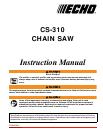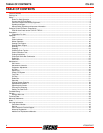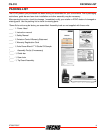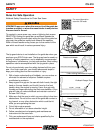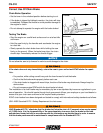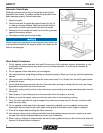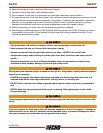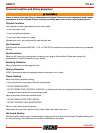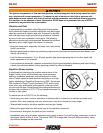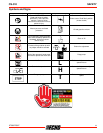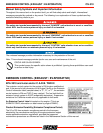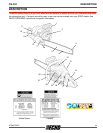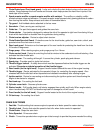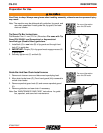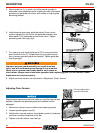
CS-310 SAFETY
© 08/2013 ECHO Inc.
X7503270007 5
Correct Use Of Chain Brake
Chain Brake Operation
• Set the lever in the unlocked position before starting to cut.
• If the brake is tripped by kickback reaction, the chain will stop
immediately. Release the throttle to avoid possible damage to
the engine or clutch.
• Do not attempt to operate the engine with the brake locked.
Testing The Brake
• Start the engine on a solid level surface and run at a fast idle
until warm.
• Hold the saw firmly by the handles and accelerate the engine
to a fast idle.
• Slowly operate the chain brake lever while holding the saw
firmly on the ground. When the brake lever trips, the chain
should stop. Immediately release the throttle trigger.
Do not allow the saw to tip forward in order to avoid damage to the chain.
If the chain does not stop immediately, return the saw to your authorized ECHO dealer for repair.
Note:
• For practice, while cutting a small tree, push the lever forward to lock the brake.
• Confirm that the brake works properly before each use.
• If the chain brake is clogged with wood chips, function of the brake may deteriorate. Always keep the
device clean.
• Do not increase engine RPM's while the chain brake is locked.
The installation of a chain brake may be mandatory by law or as stipulated by insurance regulations in your
area of operation. You should inquire through local government offices, your employer or your local dealer to
ensure that your chain saw conforms to the required safety standard.
ECHO chain brakes have been designed and tested to comply with international safety standards as follows.
USA: ANSI Standard B175.1 Safety Requirement for chain saws
ANSI Standard B175.1 stipulates that the brake shall stop the chain 0.12 seconds at an engine speed
of 13,500 r/min. It is the responsibility of the owner/operator to ensure that the brake is serviced,
adjusted and tested strictly in accordance with the instructions as detailed here in order to ensure
that the brake performance is maintained in compliance with the Standard B175.1.
Locked
Unlocked



